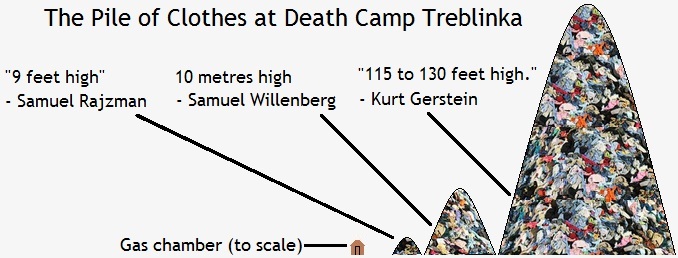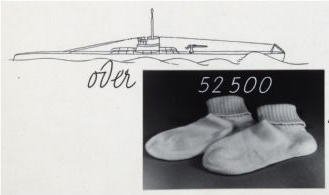"The use of engine exhaust for
mass murder had also been
exemplified since 8 December 1941 in
Chelmno, where Warthegau officials
stationed several gas vans employing
such means to gas thousands of Jews.
... Of course, there were other
gaseous methods accessible to Nazi
officials to use in order to poison
unwanted persons. For the Auschwitz
camp staff, the newly available
cyanide-based pesticide Zyklon-B
presented itself as a suitable
method to dispose of the increasing
number of Soviet prisoners of war,
sick prisoners, and Jewish laborers
who were “unfit for work.”" (p.283)
No explanation of how the Zyklon B gas
vans evolved then?
"A transport van for prisoners
was fitted up in such a way that
"Cyklon B" could be introduced
at the same time. This van
picked up prisoners at
Mauthausen concentration camp.
gassed them on the way unloaded
them at the crematorium at
Gusen, and, on the return
journey, picked up prisoners at
Gusen, again gassed them on the
journey and took them to the
crematorium at Mauthausen."
- PS-499 and Green Series Vol.5.
p.1137/8.
And considering it was Mauthausen,
the Cyklon B would have had to have
been on a "hot brick" when it was
placed in the van, as was the
gassing procedure there.
http://winstonsmithministryoftruth.blogspot.co.uk/2011/07/zyklon-b-hot-brick-shovel-jews-nonsense.html
"While this testimony was
provided nearly three decades after
the event (with the profound impact
such a time can have on one’s
memory)," (p.288)
Well, isn't that odd, on page 230,
footnote 403, HC rely on testimony
provided nearly six decades after
the event, without voicing any
such qualms.
It is also likely that the old
wooden gas chambers had been
tarnished by the sweat, blood,
urine, and excrement of the many
thousands of gas chamber victims.74"
74 Schelvis, Sobibor, p.103.
(p.292)
The cited source, on page 148,
states that the Nazi "experts" in
stains, brought in to examine
an irremovable stain on the gas
chamber floorboards, deduced that it
had been caused by the blood of
child birth, mixing with poison gas
(exhaust fumes from a previously
diesel, now petrol engine). Also HC
left out, the fragments of ears,
cheeks and hands embedded in the
floorboards. Strange that HC
controversies always seem to purge
the more ghoulish/ridiculous parts
of the eyewitness evidence.
"Jan Sulkowski ... testified
about his experience in constructing
the new (Treblinka) gas chambers:
SS men said it was to be a
bath. Only later on, when the
building was almost completed, I
realized that it was to be a gas
chamber. What was indicative of
it was a special door of thick
steel, insulated with rubber,
twisted with a bolt and placed
in an iron frame, ...
While the door was more likely to
be wooden with steel accessories and
components rather steel," (p.296)
He clearly indicates it was the door
that made him realise it was a gas
chamber! Another Jew who also built
the new Treblinka gas chambers, also
stated that it was a metal door. But
this quote doesn't make it into HC
BST even though he is discussed, and
his his memoirs are quoted at length
in their book:
"The chambers were connected
with the corridor by a
hermetically fitted iron door
leading into each of the
chambers." - Yankel
Wiernik
What motives did HC have in
dismissing the testimony of two men
who claim the gas chamber doors were
metal? If we apply HC's
petrol/diesel engine methodology,
these two men had better knowledge
than any other survivors or
Nazis/Trawnikis, as they actually
built the new chambers.
Amusingly, 10 pages later, HC write:
"While Mattogno
criticizes Wiernik for failing
to provide for an exhaust vent,
they quote the relevant
testimony from Wiernik in the
same book. Such sloppiness is
inexcusable." (p.306)
It is within that very same paragraph,
that Wiernik states the gas chamber
door was an iron door. Such
sloppiness would be inexcusable, but
more likely, it was another
deliberate omission.
"Samuel Willenberg recorded that
he viewed a pile of clothing some
ten meters high in the sorting yard,
with thousands of other objects
lying all around." (p.300)
They could have gone with Treblinka
escapee Samuel
Rajzman's believable "...
enormous piles, sometimes 9 feet
high, of clothing and shoes." But
instead went with the ludicrous 10
metre tall pile of his fellow
escapee Samuel Willenberg. Perhaps
HC feels this excuses them from even
mentioning Kurt
Gerstein's "veritable mounds
of clothing and underwear, 115 to
130 feet high." But they have
included the standard Gerstein
disclaimer on page 331 "...
exaggeration, something Gerstein was
prone to in his accounts."
"166 Pohl to Himmler, 6.2.1943,
NO-1257: “women's hair 1 car 3,000
kg” " (p.314)
MAXWELL-FYFE: ... it took 5
minutes extra to kill the women
because they had to have their
hair cut off as it was to be
used for making mattresses. Was
nothing ever told you about this
accretion to German material,
which came from the effects of
these people who were murdered?
GOERING: No, and
how can you imagine this? I was
laying down the broad outlines
for the German economy, and that
certainly did not include the
manufacture of mattresses from
women's hair or the utilization
of old shoes and clothes.
- IMT March 21, 1946. Blue
Series V.9 p.612
Auschwitz survivor Bernhard Lauber
testified at the 4th Nuremberg
Military Tribunal April 11, 1947:
All the clothing was
assembled in the so-called
material camp and from there it
was sorted out and loaded on
trains, and called "presents for
Pohl."
- NMT Green Series Vol. 5, p.650
"There should be a charge of RM
—.50 for each kg of hair."
- Maurer to main camps, 4.1.1943,
PS-3680
So the 400 kg of hair from Treblinka
to the Paul Reimann Company (p.314),
would have netted the Reich,
RM—200.00, approximately $500.00,
worth $6,676.69 in 2012!
And what were the "Hair
cutting machines" the
Germans stole from the Jews?
- Maurer to Himmler, 13.5.1943,
NO-2003
"... the hairdresser, who cuts
off their hair in one or two
strokes, after which it vanished
into huge potato bags 'to be used
for special submarine equipment,
door mats, etc.', as the SS
Unterscharfuehrer on duty told me."
- Kurt Gerstein
"Note should be made of Glücks’
August 6, 1942 directive to several
concentration camps ordering the
hair of concentration camp prisoners
was to be put to use if it met a
specified length requirement. The
hair was to be made into industrial
felt, or spun into yarn. Gluck
specified the use of the hair as
follows: “Out of combed and cut hair
of women, hair-yarn socks for U-boat
crews are to be made, as well as
hair-felt stockings for employees of
the Reich railways.” USSR-511; IMT
Vol. XX, p.353." (p.314)
What a coincidence it is, that "socks
for U-boat crews" also
featured in an unquestionably
genuine German document regarding
the use of hair,
captured by the Allies at Himmler's
Alpine villa during the winter of
1944-5
"We also find it unlikely for the
breakdown to have occurred, as it
was emphatically denied by
Pfannenstiel, who clearly stated to
have seen the engine." (p.324)
HC mention (p.331) that Gerstein had
a tendency to exaggerate in his
accounts, but here they are accusing
him of completely fabricating an
entire event, one which he detailed
in minutiae:
After two hours and 49 minutes -
the stop watch has registered
everything well - the diesel
starts.
Unfortunately HC don't share their
opinion on why they believe Gerstein
lied, his reason for doing so and
the implications of this.
"Globocnik was also eager to
destroy as many documents related to
the camps as he could, writing to
Himmler in January 1944 that "all
vouchers should be destroyed as soon
as possible, as has been done in the
case of all other documents
pertaining to this
operation (Reinhard)."" (p.334)
"In the case of the Aktion
Reinhard camps, the destruction of
files is a documented fact, as we
know from Odilo Globocnik's final
report on Aktion Reinhard to
Heinrich Himmler." (p.25)
Strange, ironic even, that
Globocnik's letter to Himmler
January 5, 1943, his "final report
on Aktion Reinhard", which states
all documents pertaining to Aktion
Reinhard should be destroyed, wasn't
itself destroyed. Has anyone
(outside the 75%
Jewish staff of the
Nuremberg trials) ever seen the
original letter known as 4024-PS?
"... reasons that precluded
excavations in the mass grave areas
at Belzec, i.e. concerns of
religious Jews about what they
considered a desecration of the
dead." (p.338)
This excuse has been exposed as a
lie. Jews regularly "desecrate" the
graves of their dead:
Achuzat Kever helps Jewish
families, worldwide, bring their
loved ones to their final
resting place in Israel. We also
arrange exhumations anywhere in
the world for the purpose of
transferring the mortal remains
to Israel.
And they'll "desecrate" graves for
monetary gain:
If it is believed that
valuables have fallen into the
earth that was used to fill in
the grave.
A plethora of examples of Jews
"desecrating" Jewish graves and this
being in full accord of Talmudic Law
can easily be shown





































